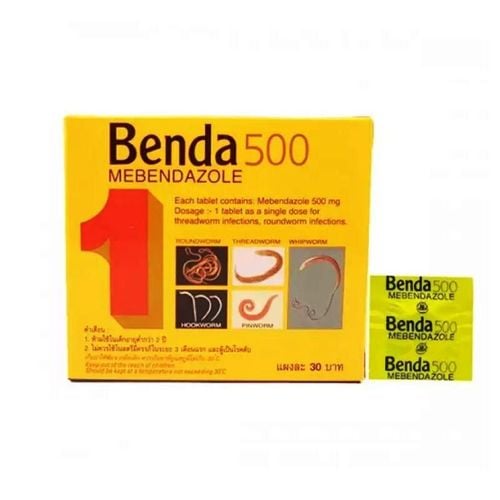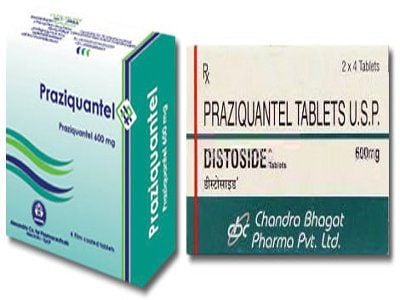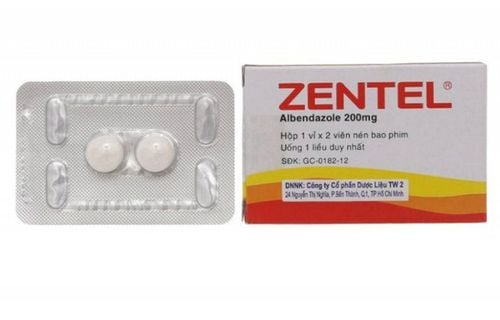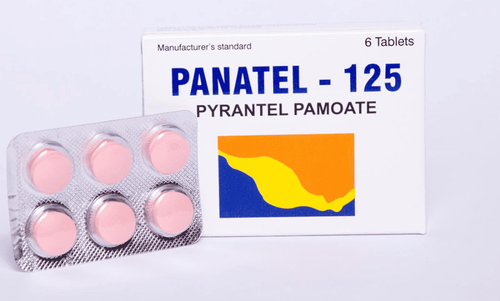This is an automatically translated article.
Thiabendazole is an active ingredient that kills some helminth species. This active ingredient has the trade name Vazigoc 500mg. So what is Vazigoc and how is it indicated?
1. What is Vazigoc?
What is Vazigoc? Vazigoc contains the active ingredient Thiabendazole 500mg, prepared in tablet form for oral use. Thiabendazole is a drug that kills a number of worms such as roundworms (Ascaris lumbricoides), strongyloides (Strongyloides stercoralis), hookworms (Necator americanus, Ancylostoma duodenale), hairworms (Trichuris trichiura), and hookworms of dogs and cats (Ancylostoma). braziliense), dog roundworm (Toxocara canis), cat roundworm (Toxocara cati) and pinworm (Enterobius vermicularis). It should be noted that Thiabendazole in Vazigoc, in addition to inhibiting worms from producing eggs and larvae, also prevents the development of eggs or larvae when it is excreted in the feces.
The mechanism of action of Vazigoc on worms has not been precisely determined, but it is highly likely that it is due to inhibition of the enzyme Fumarate reductase, a specific enzyme of helminth species.
2. Indications and contraindications of Vazigoc
Vazigoc is indicated in the treatment of strongyloidiasis (Strongyloidiasis) with larvae migrating under the skin or visceral, trichinosis and some other worms. In addition, Vazigoc is also used when other therapies are ineffective or contraindicated or require a second drug combination to treat hookworm infections (Necator americanus, Ancylostoma duodenale), hairworms (Trichuriasis). ) or roundworm (Ascariasis). The use of Vazigoc is contraindicated if the patient is allergic to Thiabendazole or to any of the ingredients in Vazigoc.
Note that Vazigoc should not be used for the purpose of preventing pinworm infection (Enterobius vermicularis).
3. Dosage, how to use Vazigoc
How to use: Patients should take Vazigoc tablets after meals and should chew the tablets before swallowing.
Dosage of the drug Vazigoc needs to be prescribed by the doctor. The maximum recommended daily dose is 6 Vazigoc tablets (3g Thiabendazole) divided into 2 oral doses and can be adjusted according to the patient's weight as follows:
13.6kg: 250mg (1⁄2 Vazigoc tablets)/ time; 22.6kg: 500mg (1 Vazigoc pill)/time; 34kg: 750mg (1.5 Vazigoc tablets)/time; 45kg: 1g (2 Vazigoc pills)/time; 56kg: 1.25g (2.5 Vazigoc pills)/time; 68kg: 1.5g (3 Vazigoc pills)/time. How to use Vazigoc in some specific regimens:
Strongyloidiasis: 2 times a day x 2 days or a single dose of 50mg/kg but the risk of side effects is higher: Strongyloidiasis larval status Move under the skin: 2 times/day x 2 days. If Vazigoc is discontinued for 2 days and symptoms are still present, a second course of treatment may be considered; Strongyloidiasis larvae move in internal organs: 2 times/day x 7 days; Trichinosis: 2 times/day x 2-4 consecutive days depending on individual patient response. However, there is no optimal dose of Vazigoc for the treatment of trichinosis; Roundworm (Ascariasis), hookworm (Uncinaria Sis) and whipworm (Trichuriasis): 2 times/day x 2 days or a single dose of 50mg/kg. Some notes on the use of Vazigoc:
Vazigoc is only used for patients with confirmed worm infections; Vazigoc should not be indicated as the first line of treatment for pinworms, but should only be used if the patient cannot tolerate side effects or when other therapies fail; When a hypersensitivity (allergic) reaction occurs, Vazigoc must be discontinued immediately.
4. Side effects of the drug Vazigoc
During the use of Vazigoc, patients may experience some of the following side effects:
Digestive disorders such as loss of appetite, nausea, vomiting, diarrhea, epigastric pain; Jaundice, biliary obstruction or damage to the liver parenchyma, liver failure; Dizziness, drowsiness, lightheadedness, headache, seizures, depression, floating feeling, muscle weakness and lack of coordination; Tinnitus, unusual feeling in the eyes, blurred vision, decreased vision; Lower blood pressure ; Increased blood sugar; Transient leukopenia; Hematuria, urine with an unpleasant odor or crystals; Hypersensitivity reactions such as pruritus, fever, angioedema, skin rash, erythema multiforme (including Stevens-Johnson syndrome) and lymphadenopathy; Appearance of roundworms in the nose and mouth.
5. Drug interactions of Vazigoc
Thiabendazole competes with Theophylline at the site of metabolism in the liver, so when combined with Vazigoc, the concentration of both active substances in the serum will increase to the toxic threshold.
When Vazigoc is used concomitantly with xanthine derivatives, it is necessary to anticipate and plan to monitor blood levels or consider reducing the dose.
6. Be careful when using Vazigoc
Use caution when using Vazigoc in the following cases:
Vazigoc is not suitable for the treatment of patients with mixed Ascaris infections, due to the risk of stimulating them to move in the body. The symptoms of worm infection should be prioritized before treating the worms, including anemia, dehydration, or malnutrition. Patients with a history of jaundice, decreased bile secretion, and liver parenchymal damage must inform their doctor before taking Vazigoc. Patients with liver and kidney dysfunction should be closely monitored during the course of taking Vazigoc. In very rare cases liver damage may worsen and be unlikely to be relieved by treatment with Vazigoc . Because of the possible central nervous system side effects, patients should avoid neurological activities that require alertness while taking Vazigoc. Vazigoc should not be used in pediatric patients weighing less than 13.6 kg. There are no adequate studies on the difference between the elderly (over 65 years of age) and the young in the use of Vazigoc. In general, care should be taken when prescribing Vazigoc to this patient, should start with the lowest dose and monitor liver, kidney, and heart function regularly as well as monitor for other diseases and drugs that the patient is taking. treatment. Vazigoc is completely metabolised in the liver and the metabolites are excreted by the kidneys. Therefore, the risk of nephrotoxicity is high if the patient has a history of renal failure. It should be noted that the majority of elderly patients have reduced renal function, so when using Vazigoc, it is necessary to choose the dose carefully. Because there are no adequate and well-controlled studies in pregnant women, Vazigoc should only be used when the potential benefit outweighs the potential risk to the fetus. It is not known whether Thiabendazole is excreted in human milk. Therefore, Vazigoc should not be used in nursing patients. Vazigoc medicine causes dizziness and drowsiness, so it is not recommended for people to drive and operate machinery. Thiabendazole is an active ingredient that kills some helminth species. This active ingredient has the trade name Vazigoc 500mg. The drug is indicated for the treatment of a number of parasitic helminthic diseases. To ensure the effectiveness of treatment and avoid unwanted side effects, patients need to strictly follow the instructions of the doctor, professional pharmacist.
Follow Vinmec International General Hospital website to get more health, nutrition and beauty information to protect the health of yourself and your loved ones in your family.
Please dial HOTLINE for more information or register for an appointment HERE. Download MyVinmec app to make appointments faster and to manage your bookings easily.













